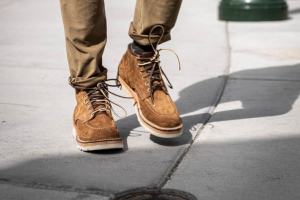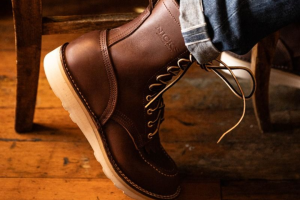What Is Used To Tan Leather?

What's used to tan leather? Generally, there's vegetable-based and mineral-based compounds for tanning. The tanning method does affect the end product, so that's why "chrome-tanned" and "vegetable-tanned" leathers can be very different in appearance and feel.
Tanning is just one step in the process of making leather, as the process in and of itself is just a chemical treatment of skin to preserve it.
But...what does this have to do you with you and the pair of leather work boots or heritage boots you want to buy? How the leather is made impacts how your boots look, feel and what you need to do to keep them in top condition.
If you're going to invest in a seriously great pair of boots, you should get leather that looks how you want, feels how you want, and that you'll be able to keep for a very long time. So let's learn a little more about tanning.
What IS Tanning Leather, Anyway?
The process of "tanning" is treating leather with a preservative compound of some sort, which classically is some sort of acidic solution.
What happens is that the skin of whatever animal the leather is made from comes to the tannery "in the white," or essentially fresh off the carcass, and has to be treated to keep it from decomposing. The tanning solution changes the composition of the proteins in the skin so that they're inherently stable, halting organic decay in its tracks.
A number of compounds have been used by various cultures all over the world.
What Is Used To Tan Leather?
Ancient tanning was not something you wanted to be around. Salt and lime were used to dry out the hides, along with literally using bodily wastes (urine and feces both) to soften and preserve the leather.
That's why tanneries were often kept far away from settlements and why leather workers were sometimes treated as untouchables in caste societies.
The Native Americans favored a method called brain tanning, which uses a slurry of brain tissue and water to alter the protein structures after scraping away hair and connective tissue. After applying the brain-water slurry, the hide is smoked to preserve it. The product is unlike any other leather product; brain-tanned buckskin is unbelievably soft yet very resilient, rivaling the softest calfskin or kid skin.
Ancient cultures in western Europe started to use the bark of the oak tree (tannum in Latin, from which we get the word "tanning") which has a high concentration of tannin, an acidic compound.
Naturally, this led to someone trying to come up with a better way to preserve hides, which led to the discovery that various mineral salts could accomplish the same effect, especially chromium salts.
Most Leather Made Today Is Chrome-Tanned Or Veg-Tanned Leather
While there are a very small number of people still brain-tanning in the Americas, almost all leather (globally speaking) is either vegetable-tanned or chrome-tanned. There are some hybrid methods, but those are the dominant methods.
Vegetable-tanned leather uses either oak bark or tannins sourced from other vegetable sources (common sources of tannins include legumes, some nuts, various fruits such as strawberries and grapes, coffee beans and tea leaves) in a chemical bath to soak the leather and alter the structure of the proteins in the skin, preserving the hide.
Chrome-tanned uses a salt bath or brine with a generous concentration of chromium salts, which do essentially the same job as tannins.
What's the difference?
Chrome-tanned leather tends to be much softer, and also tends to finish tanning in much less time than a vegetable tan. However, because it's so well-suited to high-volume production, a lot of chrome-tanned leather tends to be (but isn't always) lower quality; it's a great method for producing a lot of leather really quickly.
That said, chrome-tanned leather can make very good shoes and boots. Some people prefer it as they find break-in is faster and less painful.
Vegetable tanning tends to (but not always) produce a hardier product. Vegetable-tanned leathers are common for working applications like saddles and horse tack, leather belts, gun holsters and knife sheaths, and of course as footwear.
Veg-tanned leather boots and shoes can feel a little stiff at first, taking a little longer to break in and have a more substantial feel to them. However, the rich color that many vegetable-tanned leathers have is highly desirable, and they develop amazing patina with time and wear.
There are also some hybrid leathers, which are made with either a tanning solution with both compounds (vegetable and chrome) in the tanning bath, or are treated to one and then the other. The most famous example is Horween Leather Co's Chromexcel, but a number of other leather companies use a similar process.
Using both methods gives the leather the pliability of chrome-tanned but the strength of vegetable tanning, making it suitable for working applications but incredibly good-looking at the same time.
It's not so much that one process is "better" than the other; it's more that each process yields slightly different properties. If you use leather of good quality, you get a great pair of boots either way.




